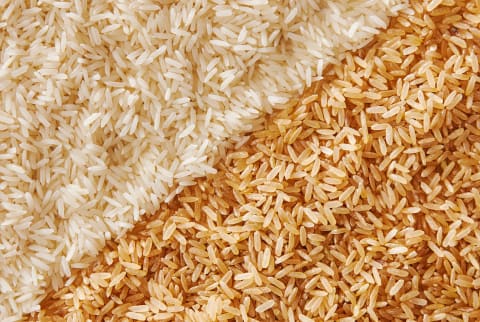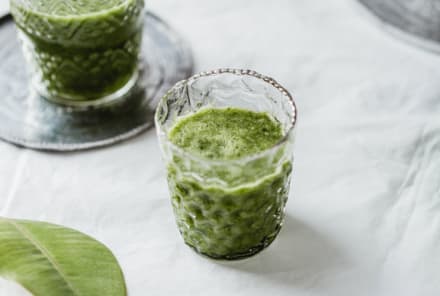Advertisement
Brown Rice vs. White Rice: Which Is Healthier?

Hannah Frye is the Assistant Beauty Editor at mindbodygreen. She has a B.S. in journalism and a minor in women’s, gender, and queer studies from California Polytechnic State University, San Luis Obispo. Hannah has written across lifestyle sections including health, wellness, sustainability, personal development, and more.


Every day, we navigate a maze of nutritional decisions—oat milk or regular milk? White bread or whole grain? Chicken or fish? Tofu or tempeh? Amid this array of choices, there's rarely a clear-cut right or wrong.
Instead, we're faced with a plethora of nutrients to weigh and nuanced recommendations to fit our individual health goals. Today, we delve into one of the most prevalent "this vs. that" quandaries in nutrition: Brown rice vs. white rice—which reigns supreme?
The need-to-knows
- Brown rice is more nutrient-dense than white rice…which makes it a healthier option
- Brown rice can support gut health, balanced blood sugar, and metabolic health
- White rice isn't bad for you…and can be a better option for those who struggle to digest fiber or to soothe an occasional stomachache
The differences between brown and white rice
Let's begin by getting to know our different grains a little better. First up, we have brown rice—a minimally processed whole grain best known for its high fiber content1. "Brown rice is considered a whole grain because it retains all parts of the grain kernel (the bran, germ, and endosperm)," explains nutritionist and founder of Real Nutrition Amy Shapiro, R.D., CDN.
On the other hand, we have white rice, which is not considered a whole grain. "The bran of brown rice, a whole grain, is removed to make white rice, a refined grain," says Traditional Chinese Medicine (TCM) chef and dietitian Zoey Gong, R.D.
While brown rice is the more nutrient-dense option, it's consumed much less often compared to its refined counterpart. A study conducted in Nepal revealed that the majority of participants harbored aversions to brown rice2, citing several reasons, such as:
- Not knowing the nutritional benefits of brown rice
- Not knowing how to cook brown rice compared to white rice
- Previously disliking the taste
- A higher price point compared to white rice
If this scenario feels familiar, you're in the right spot. Here, we're providing an expert-backed crash course on the benefits of brown rice, its nutritional comparison to white rice, recent research findings on this whole grain, and identifying who should pay extra attention to their rice choices.
The health benefits of brown rice
Below, a few reasons brown rice tends to be a healthier choice:
Brown rice is better for your gut microbiome
As mentioned above, brown rice contains the outer bran layer3 and germ, both of which are rich in fiber, vitamins, minerals, and phytonutrients, says microbiome researcher, microbiologist, and Ayurvedic clinician Christine Tara Peterson, Ph.D.
"These components are prebiotic, as they support the growth of beneficial gut bacteria and promote overall gut health," she adds. So, when this outer layer is removed, you lose a host of those gut-supporting nutrients4.
In the white rice vs. brown rice debate (isolating it from other dietary considerations), opting for white rice could potentially result in a less diverse gut microbiome. This, in turn, may lead to diminished fermentation in the colon, a factor linked to increased gas and worsening symptoms of irritable bowel syndrome (IBS)5 among individuals grappling with gut health issues.
Summary
Brown rice is better for blood sugar balance
If there's anyone who should be extra picky when it comes to choosing brown rice over white rice, it's those with diabetes or general blood sugar concerns.
"Brown rice is generally recommended for people with diabetes due to its lower glycemic index6 and higher fiber content, which help regulate blood sugar levels and promote satiety," Peterson says.
Some research suggests that swapping white rice for brown could even reduce the risk of Type 2 diabetes risk by 16%7, and replacing white rice with whole grains in general could lower the risk by 35%.
However, a recent research review including participants with prediabetes and Type 2 diabetes found no significant effect on glycemic index control8 when swapping white rice for brown rice. Still, in that same review, researchers found that choosing brown rice reduces body weight and increases beneficial HDL-cholesterol level in those with diabetes, so there were still worthwhile benefits for the group.
Additionally, it's worth noting that brown rice has been shown to lower cholesterol9, which may help to reduce the already increased risk of cardiovascular disease10 for those with diabetes, Shapiro notes.
Summary
Brown rice is better for weight management and metabolism
For those focused on weight management and boosting metabolism, brown rice seems to come out on top. Research shows that brown rice consumption significantly helped study participants lose weight11 (as measured by both pounds and waist circumference), when compared to white rice consumption.
Several factors come into play here, with one significant aspect being the variance in fiber content, notes Shapiro. Fiber-rich foods significantly enhance the sensation of satiety after a meal, a critical element for managing weight and promoting weight loss, she emphasizes.
As previously discussed, brown rice aids in maintaining stable blood sugar levels, and insulin also influences weight management12.
Summary
So, is white rice bad for you?
It's pretty clear that brown rice is more nutrient-dense and thus, generally regarded as the healthier option. Nevertheless, this doesn't mean white rice is unhealthy, either.
I don’t think anyone should avoid white rice and view it as plague.
"I don't think anyone should avoid white rice and view it as plague," Gong says.
She continues, "It's important to know that in many East Asian cultures, people eat white rice every day as their main carbohydrate in a balanced, healthy diet," which emphasizes the importance of what foods you pair with your rice.
Knowing that white rice comes with fewer nutrients (fiber included), you may consider pairing your white rice with fiber and nutrient-dense foods to compensate—think beans, broccoli, artichoke, Brussels sprouts, lentils, etc.
You can also cook your white rice in bone broth for added protein, or mix in spices like ginger and turmeric to elevate the antioxidant content and flavor.
Why TCM praises white rice
Arguments against brown rice
Like many foods out there, brown rice does have some downsides—mainly when consumed at high volumes or on a daily basis. Most notably, brown rice contains trace amounts of arsenic, which is held in the outer layer, hence why white rice has significantly lower concentrations.
But don't worry, none of the products included in an investigation by the FDA Center for Food Safety and Applied Nutrition13 found high enough levels of arsenic to be classified as acute toxicity. Still, the health effects of long-term low-dose exposure are unclear.
Another potential drawback of consuming brown rice is that its high fiber content can pose challenges for individuals with highly sensitive digestive systems or those currently dealing with gut imbalances. While brown rice is generally beneficial for gut health, it might not be the optimal choice for individuals currently experiencing digestive discomfort or difficulties digesting food.
Other grains to consider
Now, if you want to make the swap toward a more nutrient-dense grain but brown rice isn't cutting it flavor-wise, don't worry—there are plenty more options to consider. Below, a few of Shapiro's best recommendations:
- Quinoa
- Barley
- Farro
- Bulgur
- Cauliflower rice
- Millet
- Wild rice
You can also begin to mix brown rice into your white rice to help your flavor palate adjust to the new grain, should you feel inspired to make the switch.
No matter what you choose, be it brown rice or white rice, remember to look at what else is on your plate and aim for balance all around.
FAQ
Is brown rice healthier than white rice?
Brown rice contains more fiber and nutrients than white rice, making it the healthier option for most people, especially those with blood sugar, weight, or gut health concerns.
What is the healthiest rice to eat?
Brown rice is typically considered the healthiest rice option; however, black rice and red rice are also rich in fiber, antioxidants, and other good-for-you nutrients.
Is brown rice OK for diabetics?
Brown rice is generally better for diabetics than white rice. Still, it's a good idea to limit brown rice consumption to ½ a cup daily.
The takeaway
When comparing brown and white rice, the former takes the cake for nutrient density. The additional fiber and prebiotics contribute to the grain's benefits for gut health, blood sugar, and metabolic health.
This doesn't mean white rice is bad for you but rather brown rice packs a stronger nutrient punch. If you're seeking more fiber on your plate but aren't ready to make the switch, consider sprinkling these fiber-rich foods into your daily menu.
13 Sources
- https://fdc.nal.usda.gov/fdc-app.html#/food-details/169704/nutrients
- https://www.ncbi.nlm.nih.gov/pmc/articles/PMC9179153/
- https://www.ncbi.nlm.nih.gov/pmc/articles/PMC6025443/
- https://pubmed.ncbi.nlm.nih.gov/33336992/
- https://www.ncbi.nlm.nih.gov/pmc/articles/PMC4983766/
- https://pubmed.ncbi.nlm.nih.gov/29235555/
- https://www.ncbi.nlm.nih.gov/pmc/articles/PMC3024208/
- https://www.ncbi.nlm.nih.gov/pmc/articles/PMC8164413/
- https://www.cambridge.org/core/journals/british-journal-of-nutrition/article/substituting-brown-rice-for-white-rice-on-diabetes-risk-factors-in-india-a-randomised-controlled-trial/A0778FC028F6F25D0E6A73787EECECC4
- https://www.cdc.gov/diabetes/library/features/diabetes-and-heart.html#:~:text=If%20you%20have%20diabetes%2C%20you,are%20to%20have%20heart%20disease.
- https://www.tandfonline.com/doi/full/10.1080/10408398.2021.1914541
- https://www.ncbi.nlm.nih.gov/pmc/articles/PMC6832997/
- https://www.ncbi.nlm.nih.gov/pmc/articles/PMC10375490/#:~:text=In%20rice%2C%20inorganic%20arsenic%20is,rice%20than%20in%20white%20rice.
Watch Next
Enjoy some of our favorite clips from classes
Enjoy some of our favorite clips from classes
What Is Meditation?
Mindfulness/Spirituality | Light Watkins
Box Breathing
Mindfulness/Spirituality | Gwen Dittmar
What Breathwork Can Address
Mindfulness/Spirituality | Gwen Dittmar
The 8 Limbs of Yoga - What is Asana?
Yoga | Caley Alyssa
Two Standing Postures to Open Up Tight Hips
Yoga | Caley Alyssa
How Plants Can Optimize Athletic Performance
Nutrition | Rich Roll
What to Eat Before a Workout
Nutrition | Rich Roll
How Ayurveda Helps Us Navigate Modern Life
Nutrition | Sahara Rose
Messages About Love & Relationships
Love & Relationships | Esther Perel
Love Languages
Love & Relationships | Esther Perel











